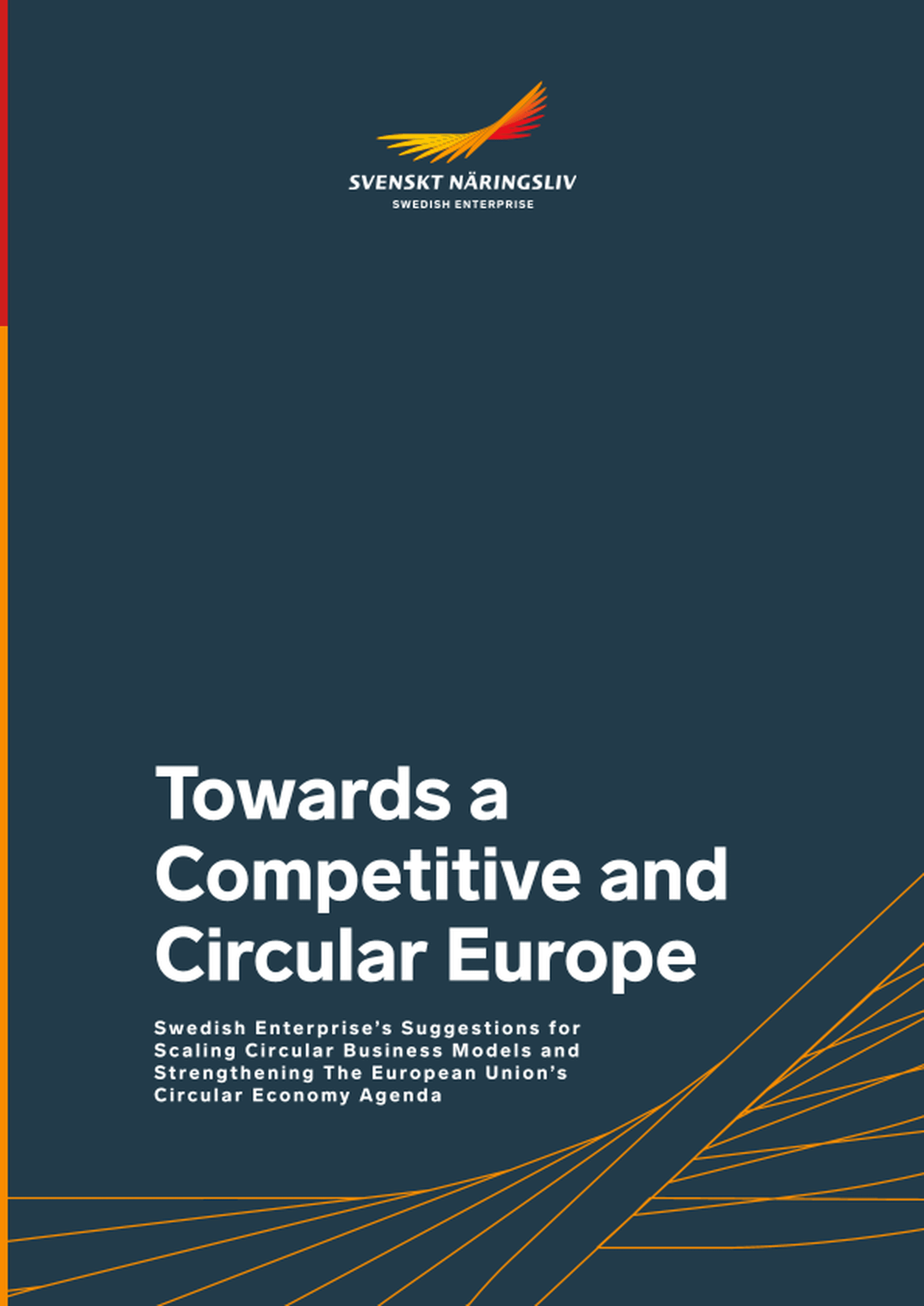Towards a Competitive and Circular Europe: Swedish Enterprise’s Suggestions for Scaling Circular Business Models and Strengthening The European Union’s Circular Economy Agenda

Europe’s transition to a circular economy must go hand in hand with industrial competitiveness, innovation and open markets. This paper holds 14 recommendations from the Swedish business community on how to make the circular economy work better for companies, large and small, while strengthening Europe’s resilience and environmental performance. These should be considered by the European Commission when developing the upcoming Circular Economy Act, but also in a wider policy context.
Swedish Enterprise argues that circularity cannot be achieved through regulation alone. Instead, the EU must take a holistic, market-oriented approach that supports innovation, investment and efficient use of resources across all material flows. Policy should enable, not prescribe; it must promote flexibility, and encourage voluntary business-led initiatives where they are effective.
Among the key proposals are investing in R&D and recycling infrastructure, enabling cross-border flows of secondary raw materials, harmonising end-of-waste criteria and scaling reverse logistics and return systems for reusable products. The paper also calls for better alignment of EPR systems, simpler VAT rules, and circular public procurement that is ambitious yet realistic.
The circular economy is not a one-size-fits-all. Different sectors and materials face distinct challenges, from technical limitations and uneven access to secondary raw materials, to regulatory fragmentation and market immaturity. Policy must reflect this diversity. A more nuanced, evidence-based approach will ensure that circularity measures are both effective and proportionate, avoiding unnecessary burdens on companies and ensuring that new rules support rather than stifle innovation.
Equally important is the role of economic incentives and enabling conditions. Circular business models require functioning markets, skilled labour, access to infrastructure, and stable regulatory environments. To unlock private investment and innovation at scale, particularly from SMEs, Europe must reduce legal uncertainty, improve permitting processes, and ensure coherence across climate, product and waste legislative fields. In short, the transition must be grounded in operational realities and shaped in close dialogue with those building the solutions on the ground.
Where additional demand-stimulating tools, such as recycled content quotas, are considered, they must be applied only where justified and always as part of a broader policy mix. The EU should also resist protectionist tendencies, ensuring that circularity goes together with open trade and fair competition.
Promote R&D and innovation through market incentives. Support research and innovation across the value chain with a focus on circular solutions, while ensuring predictable conditions for private investment and industrial scale-up.
Ensure a level playing field on a global market. Strengthen enforcement and oversight to ensure that all products on the EU market, regardless of origin, comply with EU product- and safety rules and requirements.
Circular policy must cover all material streams and value chains.Take a broad and inclusive approach that supports circularity across sectors such as plastics, textiles, construction and nutrients—not just critical raw materials.
Facilitate large-scale, cross-border flows of secondary material on the Single Market. Unlock the full potential of the Single Market by enabling the efficient and predictable movement of secondary materials across borders.
Keep global trade open to strengthen circular value chains. Avoid unjustified export restrictions and ensure responsible trade and handling of secondary materials, enabling innovation and supply chain resilience.
Foster harmonised and cost-effective EPR schemes. Modernise extended producer responsibility schemes through greater EU harmonisation, increased digitalisation and better alignment with circular design criteria.
Invest in collection, sorting and recycling infrastructure. Improve both source and downstream sorting while ensuring systems are practical and deliver clean, high-quality input for recycling.
Achieve greater resource efficiency by reducing landfilling and minimising incineration. Strengthen rules to phase out landfilling and shift away from incineration while allowing storage of materials for future circular use.
Develop and harmonize End-of-waste (EoW) criteria. Ensure legal clarity and market confidence by accelerating the development of harmonised EU-wide end-of-waste criteria for key material flows.
Facilitate the measurement and mapping of hidden residual streams. Launch EU-wide initiatives to identify and quantify underutilised resource flows to unlock new circular opportunities and industrial symbiosis.
Support reverse logistics for reusable goods and parts. Facilitate infrastructure for return logistics to enable business models like product-as-a-service and support local value retention.
Use public procurement to support circular markets across the EU. Make public procurement an engine for circular demand by introducing common criteria, building capacity, and promoting lifecycle-based purchasing.
Simplify and align the VAT system with circular economy objectives. Remove distortive VAT rules that penalise circular business models by eliminating double taxation, clarifying cross-border rules, and reducing administrative burdens for reuse, repair and resale.
Apply recycled content quotas only where appropriate and justified. Use recycled content requirements selectively and in close dialogue with industry, ensuring they are targeted, practical and market compatible.